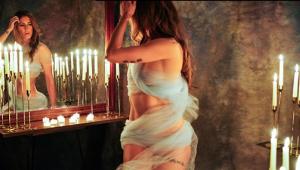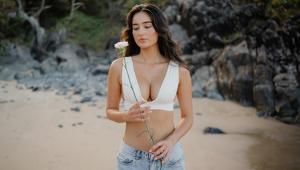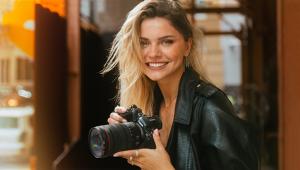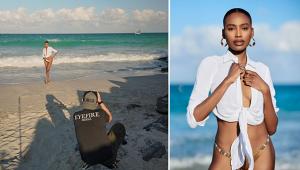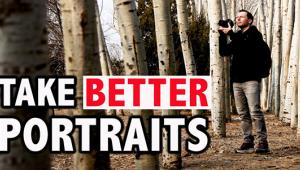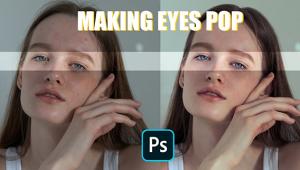10 Portrait Ideas
Try these for better people-pictures
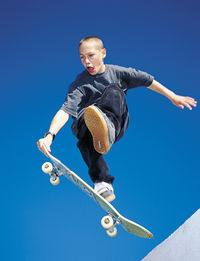 1. Action Portrait
1. Action Portrait
If a portrait subject has an active hobby, photograph him or her in action doing it. If the action is rapid, use a fast shutter speed or electronic flash (fill-flash was used for the skateboarder), and take lots of shots to enhance your chances of getting that great one. If the action is slower, you can take more time to compose. Pick a photogenic camera spot beforehand. Photo by Ron Leach
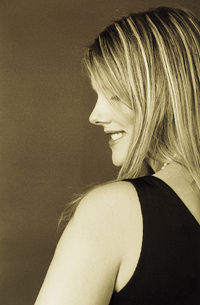 2. Profile
2. Profile
If your subject has a nice profile, take advantage of that, and do some profile portraits. Soft lighting and a plain, contrasting background generally work best, although harsh light can be effective with male subjects. Photo by Lynne Eodice
 3. Zero In
3. Zero In
A portrait doesn't necessarily have to be of the subject's face. If a person works with his or her hands, a shot of the hands can say a lot about the person. A tap-dancer's or ballerina's feet, a power-lifter's flexed arm, a hula dancer's midriff—all can make for unusual portraits. This type of image requires "abstract" thinking! Photo by Ron Leach
 4. Shadow Boxing
4. Shadow Boxing
One fun exercise is to shoot some shadow self-portraits Even Ansel Adams did some, including our favorite "Self-Portrait, Monument Valley, Utah, 1958." Nothing really tricky here: Just pick a bright, sunny day, and use your imagination. Hint: You'll get the longest, most interesting shadows (and a pleasant warmish light) right after sunrise or just before sunset, when the sun is very low in the sky. Of course, you can do shadow self-portraits indoors, too, with a studio light, but outdoors offers more variety. If you have a model, you can create compositions that include the subject and his/her shadow. Photo by Mike Stensvold
5. Fun Portrait
People having fun are always good sources enjoyable candid portraits, and kids having fun are especially appealing. Have your camera handy when you're going to be around "fun" occasions, and keep an eye out for those magical moments. Don't disrupt the fun for a photo, but in many cases you can move to a good vantage point and compose carefully.
 6. Two Together
6. Two Together
Two-person portraits offer the dual blessings of personal interaction and the opportunity to create interesting compositions. You can shoot from afar or in tight, full-length or head shot. Make sure that one subject's shadow doesn't obscure the other subject (soft lighting helps here, as does judicious placement of the light—or the subjects, if using natural light), and that both subjects are "with the picture"—you don't want one subject looking out of frame or distracted. You can direct the subjects, or just let them be themselves (start with the latter, and if that doesn't work, then give some direction.) Photo by Lynne Eodice
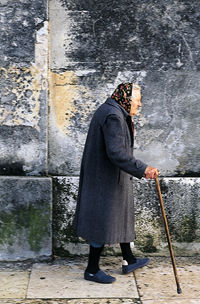 7. Street Portrait
7. Street Portrait
You can spend some fascinating hours—and get some some wonderful character shots—by people-watching from a streetside camera position. Check out the folks as they pass by, and photograph the interesting ones. When choosing your location, try to pick one that offers an attractive (or at least, non-distracting) background, and that is fairly inconspicuous. You don't want to be a "spy," but you don't want to draw undue attention, either. Photo by Ron Leach
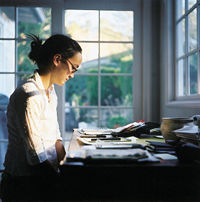 8. Windowlight Environmental Portrait
8. Windowlight Environmental Portrait
Light from a large window can be a beautiful source for portraits. The larger the window, and the closer the subject is to it, the softer the light. Here, afternoon sunlight adds a warm glow to the subject, nicely contrasting the bluish tinge of the areas of the scene not reached by the direct rays. Windowlight isn't very bright, so fast film or a tripod might be helpful. Because you're dealing with both the person and the environment, a "still life" mindset and careful composition are keys to success. Photo by Richard Kizu-Blair
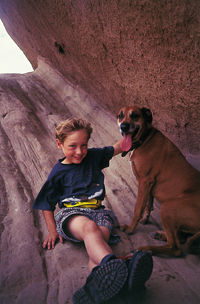 9. Take Advantage of Interesting Locations
9. Take Advantage of Interesting Locations
When you're on vacation with your family (or on an outing with friends), take advantage of the interesting locations you encounter. You can get some "different" portraits by posing your subject in unusual locales. Be aware that colored environments will reflect their color onto the subject—not a problem in this warm rocky set, but watch out amid lots of greenery. Photo by Ron Leach
 10. Easy Formal Portrait
10. Easy Formal Portrait
You don't need a lot of fancy gear to do a formal portrait. A portable background (this one was attached to a sheet of FomeCor), a soft light source (a softbox containing a flash unit, here) as the main light, and a reflector to reflect light from the main source into the shadow areas to lighten them (another sheet of FomeCor here, covered with gold foil), and you're all set. Position the main light to one side of the camera to establish the "look" of the lighting, then position the reflector to reflect some of the main light onto the shadow side of the face. Lacking the flash unit and softbox, you can position the subject close to a large window and use windowlight as the main light, positioning the reflector to reflect some of the windowlight onto the shadow side of the face. Note the tilt of the subject, and the position of the hand—portraits are more interesting if the subject isn't just standing/sitting there in a heap. Photo by Lynne Eodice





